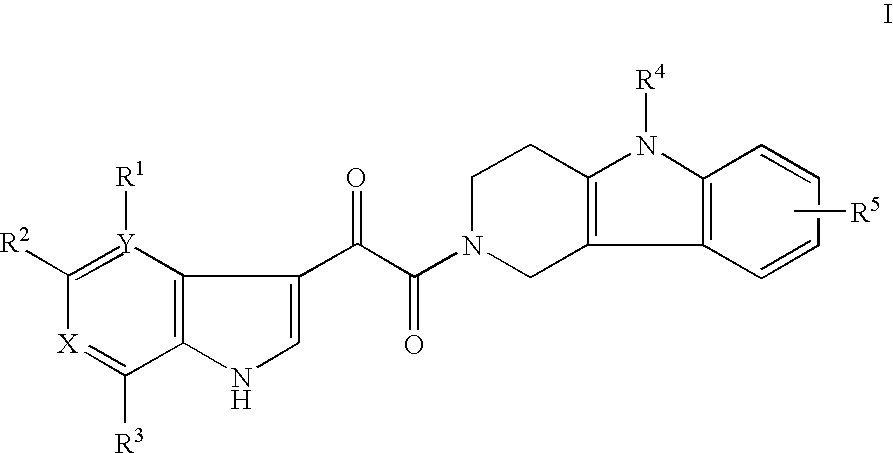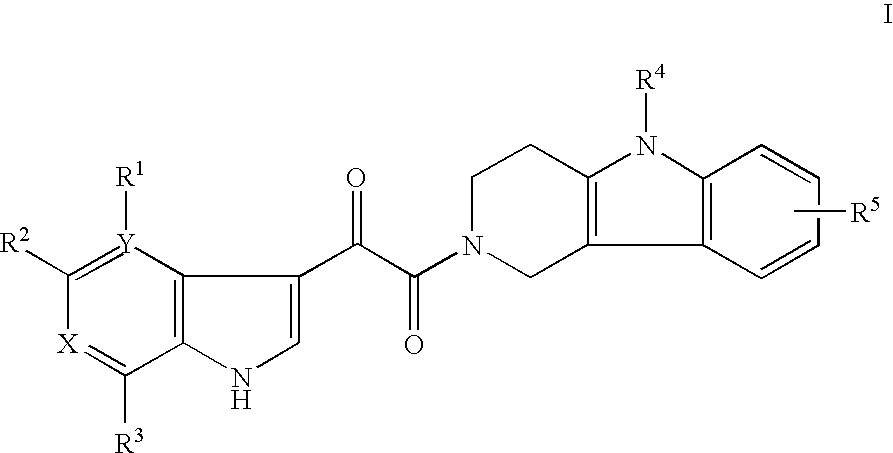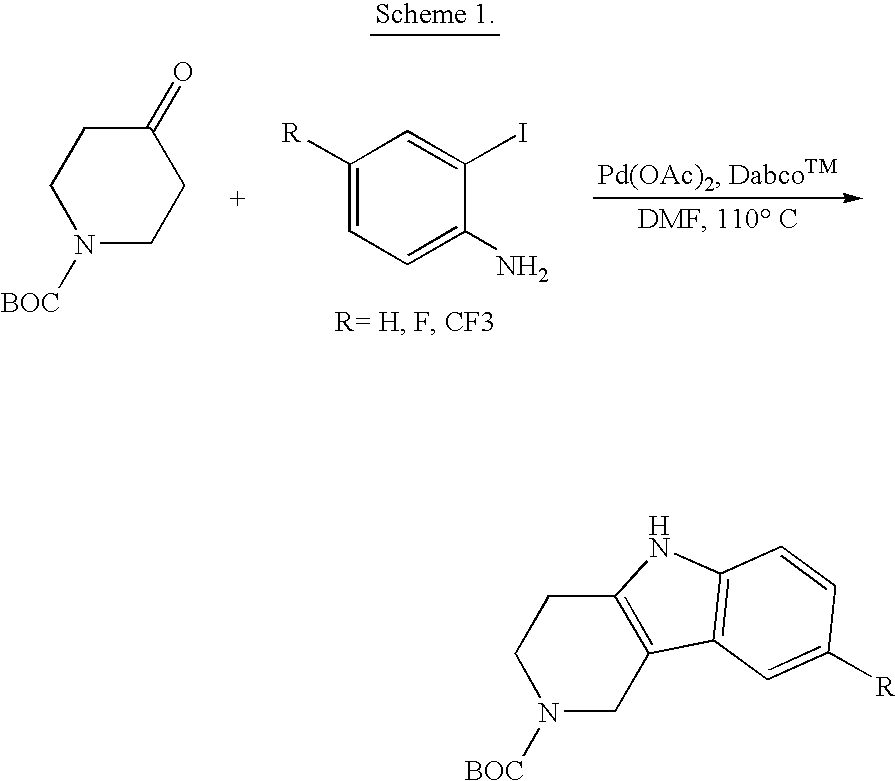Tetrahydrocarboline antiviral agents
a technology of tetrahydrocarboline and antiviral agents, which is applied in the field of tetrahydrocarboline antiviral agents, can solve the problems of affecting the effect of viremia and disease progression, and affecting the survival rate of patients, so as to achieve the effect of reducing the risk of viremia and disease progression
- Summary
- Abstract
- Description
- Claims
- Application Information
AI Technical Summary
Problems solved by technology
Method used
Image
Examples
example 1
[0072]
[0073] 1-(5-Phenyl-1,3,4,5-tetrahydro-pyrido[4,3-b]indol-2-yl)-2-(4,7-dimethoxy-6-azaindol-3-yl)-ethane-1,2-dione. General Method: A solution of 5-phenyl-1,3,4,5-tetrahydro-pyrido[4,3-b]indole-2-carboxylic acid tert-butyl ester (0.054 g, 0.155 mmol) in dry CH2Cl2 (2 mL) was treated with TFA (0.20 mL). After stirring the mixture for 1 h, the solvent was evaporated in vacuo and the residue was dissolved in CHCl3 (5 mL). To this mixture was added 4,7-dimethoxy-6-azaindol-3-yl-oxoacetic acid (0.042 g, 0.155 mmol), i-Pr2NEt (0.27 mL, 1.55 mmol) and then BOP-Cl (0.039 g, 0.153 mmol). The mixture was allowed to stir at room temperature for 2 h and then the solvent was removed in vacuo. The residue was partitioned with EtOAc-H2O, the organic phase was separated and the aqueous phase was re-extracted with EtOAc (2×). The combined organic layers were washed (H2O, brine), dried (Na2SO4) and evaporated. The residue was purified by preparative HPLC to give the title compound (0.025 g, 33%)...
example 2
[0074]
[0075] 1-(1,3,4,5-Tetrahydro-pyrido[4,3-b]indol-2-yl)-2-(4,7-dimethoxy-6-azaindol-3-yl)-ethane-1,2-dione. Prepared according to the general method to give the title compound (53% yield) as a white solid. 1H NMR (400 MHz, CDCl3) δ 9.23 (s, 0.67H), 9.14 (s, 0.33H), 8.06 (d, J=3.0 Hz, 0.70H), 7.96 (d, J=3.0 Hz, 0.30H), 7.92 (s, 0.40H), 7.89 (s, 0.60H), 7.52-6.99 (m, 5H), 4.15 (m, 1H), 4.05 (s, 2H), 4.04 (s, 1H), 3.89 (m, 2H), 3.83 (s, 1H), 3.67 (s, 2H), 3.00 (m, 1H), 2.89 (m, 2H); LCMS: m / e 405 (M+H)+.
example 3
[0076]
[0077] 1-(8-Fluoro-1,3,4,5-tetrahydro-pyrido[4,3-b]indol-2-yl)-2-(4,7-dimethoxy-6-azaindol-3-yl)-ethane-1,2-dione. Prepared according to the general method to give the title compound (15% yield) as a white solid. 1H NMR (400 MHz, DMSO-d6) δ 11.12 (s, 0.33H), 11.06 (s, 0.67H), 8.17 (s, 0.56H), 8.09 (s, 0.44H), 7.42 (s, 0.38H), 7.39 (s, 0.62H), 7.32-7.24 (m, 1H), 6.91-6.83 (m, 1H), 3.99 (m, 1H), 3.97 (s, 2H), 3.96 (s, 1H), 3.74 (s, 1H), 3.70 (m, 2H), 3.59 (s, 2H), 2.93 (m, 1H), 2.76 (m, 2H); LCMS: m / e 423 (M+H)+.
PUM
| Property | Measurement | Unit |
|---|---|---|
| Molar density | aaaaa | aaaaa |
Abstract
Description
Claims
Application Information
 Login to View More
Login to View More - R&D
- Intellectual Property
- Life Sciences
- Materials
- Tech Scout
- Unparalleled Data Quality
- Higher Quality Content
- 60% Fewer Hallucinations
Browse by: Latest US Patents, China's latest patents, Technical Efficacy Thesaurus, Application Domain, Technology Topic, Popular Technical Reports.
© 2025 PatSnap. All rights reserved.Legal|Privacy policy|Modern Slavery Act Transparency Statement|Sitemap|About US| Contact US: help@patsnap.com



